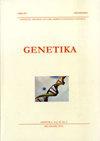Performance prediction of F1 crosses in eggplant (Solanum melongena L.) based on morphological and molecular divergence
4区 农林科学
Q3 Agricultural and Biological Sciences
引用次数: 1
Abstract
Identifying potential F1 hybrid combinations based on the parental diversity can increase the breeding efficiency and saves the opportunity cost of time. In this work, the genetic diversity between eggplant genotypes was measured by Mahalanobis D2 statistics and Sequence Related Amplified Polymorphism (SRAP) molecular markers. The genetic distances (GD) were correlated with heterosis and trait wise mean performance of F1 crosses generated in a line ? tester mating design for prediction of F1 performance for agronomically important traits. The cluster analysis performed based on the Mahalanobis D2 distance grouped all the eleven genotypes into two clusters and three clusters were formed based on the SRAP marker data. The polymorphic information content value generated by the 30 SRAP marker combinations ranged from 0.09 to 0.77 with a mean value of 0.38. For yield, the F1 combinations exhibited the mid parent heterosis ranged from 3.99% to 83.34% and the heterobeltiosis from -35.67% to 57.19%. GD based on both phenotypic values and molecular marker data successfully predicted the heterotic patterns in the number of fruits per plant and other fruit morphological traits such as fruit length and fruit breadth which is a significant outcome of the study. A multiple linear regression model that included GD, GCA and SCA was more significantly correlated with heterosis for fruit yield than any genetic parameter alone.基于形态和分子差异的茄子F1杂交性能预测
利用亲本多样性识别潜在的F1杂交组合,可以提高育种效率,节约时间机会成本。利用Mahalanobis D2统计和序列相关扩增多态性(Sequence Related Amplified Polymorphism, SRAP)分子标记对茄子基因型间的遗传多样性进行了测定。遗传距离(GD)与杂种优势和性状平均表现相关。用于预测重要农艺性状F1表现的试验配种设计。基于Mahalanobis D2距离进行聚类分析,将11个基因型分为2个聚类,并根据SRAP标记数据形成3个聚类。30个SRAP标记组合产生的多态性信息含量值范围为0.09 ~ 0.77,平均值为0.38。在产量方面,F1组合中亲本杂种优势范围为3.99% ~ 83.34%,杂种优势范围为-35.67% ~ 57.19%。基于表型值和分子标记数据的GD成功预测了单株果数和果长、果宽等果实形态性状的杂种优势模式,是本研究的重要成果。包含GD、GCA和SCA的多元线性回归模型与果实产量杂种优势的相关性高于任何单一遗传参数。
本文章由计算机程序翻译,如有差异,请以英文原文为准。
求助全文
约1分钟内获得全文
求助全文
来源期刊

Genetika-Belgrade
AGRONOMY-GENETICS & HEREDITY
CiteScore
1.80
自引率
0.00%
发文量
1
审稿时长
6-12 weeks
期刊介绍:
The GENETIKA is dedicated to genetic studies of all organisms including genetics of microorganisms, plant genetics, animal genetics, human genetics, molecular genetics, genomics, functional genomics, plant and animal breeding, population and evolutionary genetics, mutagenesis and genotoxicology and biotechnology.
 求助内容:
求助内容: 应助结果提醒方式:
应助结果提醒方式:


